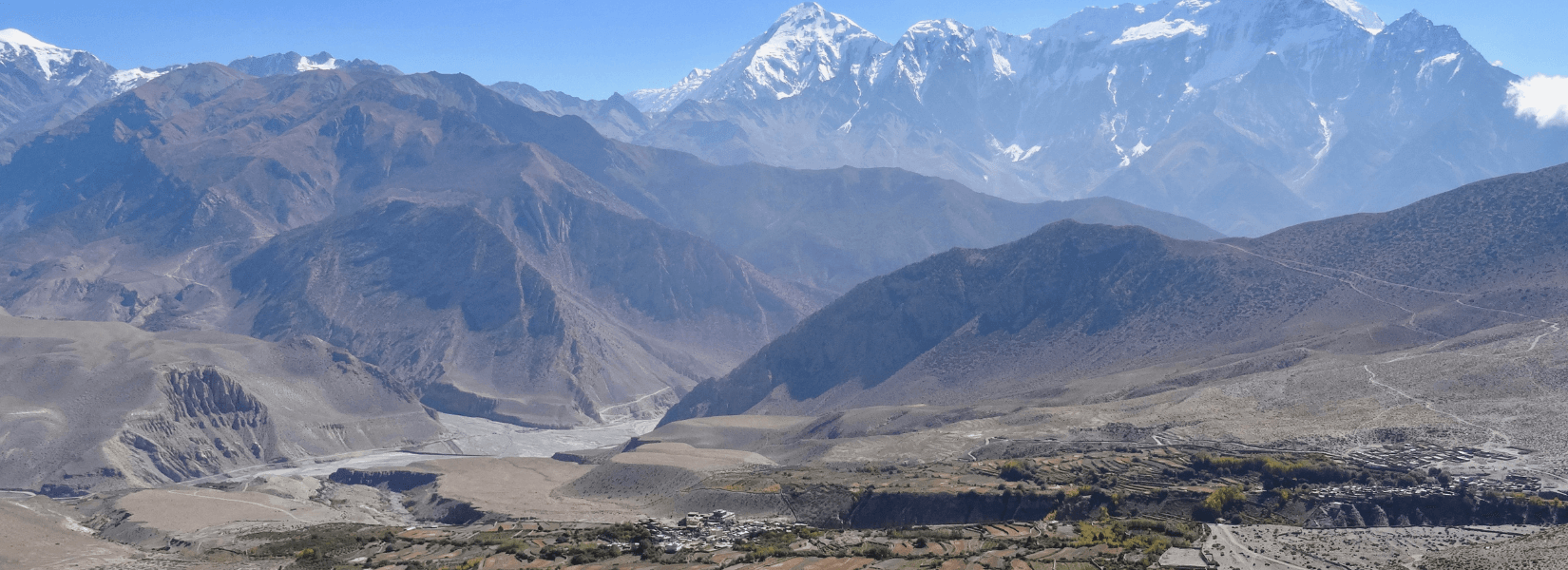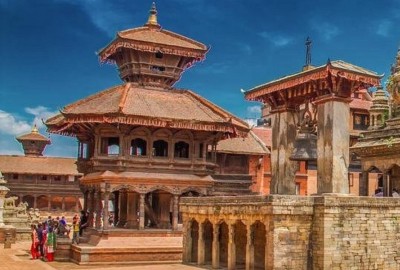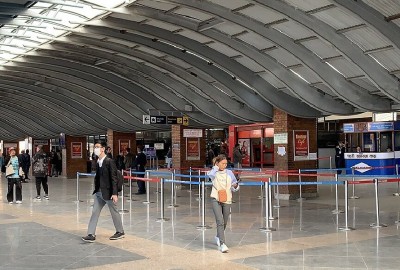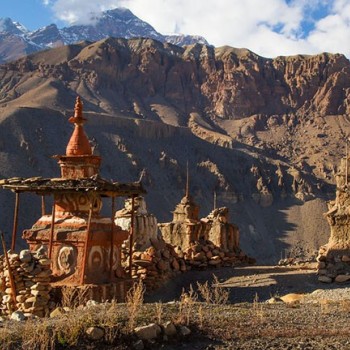Table of Contents
Plan your trip to Nepal
Customize your trip with help from a local travel specialist.
Highlights of the Upper Dolpo Trek
Magnificent Himalayan Peaks
The trek offers breathtaking views of the majestic peaks of the Dhaulagiri and Annapurna ranges, including several peaks over 7,000 meters in elevation.
Remote Villages
The trek takes you through remote villages that offer a unique insight into the traditional way of life of the people living in the region. You will have the chance to interact with the locals, learn about their culture, and experience their hospitality.
Stunning Landscapes
The trek passes through lush forests, deep gorges, high passes, and pristine lakes, offering breathtaking views of the surrounding landscapes.
Phoksundo Lake
The trek takes you to Phoksundo Lake, one of the most beautiful and serene lakes in Nepal. The lake is surrounded by towering peaks and pristine forests and is a must-visit destination on the trek.
Unique Culture
The Upper Dolpo region is home to the Dolpo people, a unique ethnic group with a rich cultural heritage. The trek offers a chance to learn about their culture, including their customs, traditions, and way of life.
Wildlife
The Upper Dolpo region is home to a diverse range of wildlife, including snow leopards, blue sheep, and various species of birds. The trek offers the opportunity to spot some of these amazing creatures in their natural habitat.
The trek starts in Juphal and takes about 17 days, passing through several villages, including Dunai, Tarakot, Shey Gomba, Namgung, Ringmo, Phoksundo Lake, Dolpo Pauwa, and Jhupal, before ending in Nepalgunj. The trek is physically demanding and requires a good level of fitness, but the rewards are worth every step, as you will experience the pristine beauty and rich culture of the Himalayas.
It is recommended to trek with a local guide and to be properly equipped with warm clothing, a good sleeping bag, and sturdy hiking boots. The trek is best done from September to November and from March to May, when the weather is dry and clear, offering the best views of the surrounding landscapes and peaks.
Outline Itinerary of Upper Dolpo Trek
The Upper Dolpo trip is a protracted, difficult hike. To get to Dolpo, you must take two flights, and then you must travel via lower Dolpo villages to get to Shey-Phoksundo Lake. Dolpo's main draw is the Shey-Phoksundo Lake.
Upper Dolpo is a restricted area further up in the mountains. To reach the unknown area of Dolpo, you journey along a high trail that passes through ancient communities and high passes. You can explore communities, go to several monasteries, make friends, and take in Upper Dolpo's natural beauty. Upper Dolpo Trek typically takes 27 days. Keep in mind that you can alter the itinerary to suit your preferences, vacation duration, and goals.
Day 01: Arrival in Kathmandu
The representative of the company will pick you up at the airport if you are traveling through a travel agency. After that, they will drive you to your hotel. They prepare you for the legal process and your hiking permits. Typically, your travel agency provides breakfast and an overnight stay in a hotel. You must therefore pay for your lunch and dinner. However, if you are traveling alone, you must locate a taxi and look for a hotel. Taxi fares may be inflated; exercise caution. Permits are therefore required for Dolpo trekking. You must locate a trustworthy tour operator because you must be accompanied by a government-approved tour operator while on the walk.
Day 02: Planning for the trek and sightseeing in Kathmandu
The day after tomorrow begins with a delectable breakfast. The guide from your trekking company might then take you on a tour of Kathmandu. Here are a few locations that have been designated as UNESCO world historic sites, including Pashupatinath, Boudhanath, and Swayambhunath.
If you need a TIMS card or a hiking permit but are traveling alone, work on getting them. Additionally, be sure to stock up on everything you'll need for the voyage. You may purchase or rent trekking equipment at Thamel, a popular tourist destination in Kathmandu. Additionally, make sure you are completely ready for your excursion.
Day 03: Fly from Kathmandu to Nepalgunj
The following day, a 45-minute flight will take you to Nepalgunj. The Mid-Western Terai contains the humid city of Nepalgunj. It is a significant city in the Mid-Western area and is located near the border between Nepal and India. Nearby to Nepalgunj is the Bardia National Park.
Bus service from Kathmandu to Nepalgunj is also available. To arrive in Nepalgunj on the third day, however, you must board a night bus on the second day of your journey. The East-West Highway is a long, but equally amazing, route. Other cities that you pass through include Narayangarh, Hetauda, Bharatpur, Butwal, and more. You'll spend the night in a hotel. Explore the city on a stroll in the evening.
Day 04: Fly to Juphal from Nepalgunj and then hike to Dunai
You will depart from Nepalgunj in the early morning and arrive at Juphal Airport. Flying through breathtaking terrain, you can see the Annapurna and Dhaulagiri mountain ranges. The only airport in Dolpa is Juphal Airport. Additionally, it was the sole way for Dolpo residents to reach other regions of Nepal. The road track to Dhadang has just opened. The inhabitants of Dolpo now have a glimmer of optimism that they will also have access to other modes of transportation. To get to Dunai after landing in Juphal, you must hike for two to three hours. The Dolpo district headquarters is located in Dunai, which is 2000 meters above sea level on the bank of the Thuli Bheri River. In Dunai, you'll be staying in a teahouse. In total, you will trek for 5 to 6 hours and will have to stay at a teahouse where breakfast, lunch, and dinner will be provided.
Day 05: Trekking to Ankhe from Dunai
The walk toward Ankhe begins the following morning. After passing over the brand-new suspension bridge, turn west and continue on the trail. To get to a crest and enter the Phoksundo River Valley, you start ascending. The journey then traverses another ridge before entering a canyon and arriving at Rahagaon. You will then hike through a thick forest to reach Ankhe. The Shey-Phoksundo National Park's territory starts in Ankhe. In Ankhe, you will spend the night. In total, you will trek for 5 to 6 hours and will have to stay in tents where breakfast, lunch, and dinner will be provided.
Day 06: Trek to Sulighat from Ankhe
The following day, you go along a trail that crosses numerous streams and wooded areas. Alongside the rough route, a river flows. The sixth night of your journey will be spent in Sulighat after a trek to Ryajik. You will trek for 5 to 6 hours in total and will have to stay in tented camps where breakfast, lunch, and dinner will be provided.
Day 07: Trek to Phoksundo Lake from Sulighat
The seventh day is a hike across the valley to the confluence of the Phoksundo and Pungmo rivers. You walk alongside the Pungmo River to Phoksundo Lake after crossing a wooden bridge. You will trek for 5 to 6 hours in total and will have to stay in tented camps where breakfast, lunch, and dinner will be provided
Day 08: Rest and acclimatization at Phoksundo Lake
To get to Shey Phoksundo Lake, you had to make a long trip. The lake is 3611 meters above sea level. Today is therefore a day of well-deserved relaxation and acclimatisation. You can stroll around Shey Phoksundo Lake's neighborhood. This breathtaking turquoise lake is a treat to behold. You can visit the surrounding Ringmo hamlet and Tibetan Buddhist Monastery. You can discover the customs and civilizations of many people. You will have to stay in tents where breakfast, lunch, and dinner will be provided.
Day 09: Trek to Phoksundo Khola
The road runs along the western edge of Shey Phoksundo Lake. You stroll down the lake's western end's rocky hillside path. The path continues through a verdant grassland to the Phoksundo Khola floodplain. In total, you will trek for 5 to 6 hours and will have to stay in tents where breakfast, lunch, and dinner will be provided.
Day 10: Trek to Phoksundo Bhanjyang
The tenth day involves walking through a glacial valley in a northerly direction until you reach the confluence of the Phoksundo River and a stream. You start an upward rise as soon as you cross the bridge and move in the direction of the northeast. You can see Kang-La pass as you go to the top of a steep slope. In total, you will trek for 6 to 7 hours and will have to stay in a tented camp where breakfast, lunch, and dinner will be provided.
Day 11: Trek to Shey Gompa through Kang-La pass
You'll arrive at Kang-La Pass on the tenth morning after making your way through a challenging track. At a height of 5,360 meters, Kang-La Pass offers spectacular views of empty valleys, Crystal Mountain, and the U-shaped canyon leading to Shey-Gompa.
As you proceed across the meadows after exiting the pass, you could encounter yaks and other animals grazing there. You also cross the same river multiple times. A scarlet Buddhist shrine welcomes you to Shey Gompa as you pass through a row of modest houses. Stay the night at Shey Gompa. In total, you will trek for 5 to 6 hours and will have to stay in a teahouse where breakfast, lunch, and dinner will be provided.
Day 12: At Shey Gompa, relaxation and acclimatization
You had been moving steadily upward for days. So that your body can adjust to the difference in altitude, you will take a well-deserved break in Shey Gompa. Take a stroll and investigate Shey Gompa. The most well-known monastery in Upper Dolpo is Shey Gompa. Shey Gompa receives hundreds of pilgrims who practice Buddhism each year. Crystal Mountain (Ribo Drugta) is located to the east of Shey Gompa. Every year, before they harvest their crops, the locals congregate and walk around this peak. You will have to stay in a teahouse where breakfast, lunch, and dinner will be provided.
Day 13: Trek through Saldang La to reach Namduna Gaun
The trek continues. You walk down a path that winds through a Juniper woodland before arriving at a rocky canyon. To get to the top of Saldang-La Pass, you have to trek along a winding path. The trail then falls steadily for a considerable distance in the direction of Namduna Gaun. Take a trip to the Namgung monastery, which is situated on the northern wall of a mountain. Stay the night in Namduna Gaun. In total, you will trek for 6 to 7 hours and will have to stay in a teahouse where breakfast, lunch, and dinner will be provided.
Day 14: Trekking from Namduna Gaun to Saldang
You begin your adventure in the morning by spending hours climbing arid hills. You begin to glimpse Saldang Village, which extends through a slope above Namga River, after 3–4 hours of walking. The largest village in Inner Dolpo is Saldang Village. Over 600 people are living here. Saldang is a town in the Inner Dolpo region with a thriving agricultural sector and terraced fields all around it. Stay the night in Saldang Village. In total, you will trek for 4 to 5 hours and will have to stay in a teahouse where breakfast, lunch, and dinner will be provided.
Day 15: Trek to Yangze Gompa from Saldang
Your third week of walking begins in Saldang village and leads you to further unexplored northern terrain. You proceed downstream the Nang Chu River toward Tiling and the community of Lurigaon. To reach Yangze village, continue walking. You may tour the Panzang River, the Yangze region, and the Bon-Po monastery here. Stay the night at Yangze village. In total, you will trek for 4 to 5 hours and will have to stay in a teahouse where breakfast, lunch, and dinner will be provided.
Day 16: From Yangze Gompa, trek to Sibu
Several pathways lead from Yangze to Sibu. The more time-consuming route passes through Shimengaon and Nishalgaon on the way to Sibu. We decide to take the quicker track by returning the way we arrived at Saldang village. The next destination is Namdo village, which is 5 kilometers long and home to 400 people. The Namdo Monastery is located not far from the Nam Khong River. You spend the final two hours of your walk-in in Sibu. Stay the night in Sibu. You will trek for 6 to 7 hours in total and will have to stay in a teahouse where breakfast, lunch, and dinner will be provided.
Day 17: Trek to Jeng-la Phedi from Sibu
On the seventeenth day, you set out on your journey, following the Nam Khong river. You might pass through herds of yaks traveling in caravans. You reach the confluence of two minor creeks after a few hours of walking. You then start your ascent to the Jeng La pass's base. Stay the night in Jeng-La Phedi. In total, you will trek for 5 to 6 hours and will have to stay in a tented camp where breakfast, lunch, and dinner will be provided.
Day 18: Trek through the Jeng La pass to Tokyu Gaon
The day begins with a two-hour ascent to the summit of Jeng La Pass (5110). Jeng La Pass offers breathtaking views of the Dhaulagiri mountain range. You then make your way down toward Tarap Valley. When you reach a creek, follow it to the settlement of Tokyu. Stay the night in the village of Tokyo. You will trek for 5 to 6 hours in total and will have to stay in a tented camp where breakfast, lunch, and dinner will be provided.
Day 19: Trek to Dho Tarap from Tokyu
The trail is simple in this area. You proceed by stopping at numerous chortens as you meander across a broad, fruitful valley. You must hike for about 4-5 hours to reach Dho Tarap. Stay the night in Dho Tarap. In total, you will trek for 4 to 5 hours and will have to stay in a teahouse where breakfast, lunch, and dinner will be provided.
Day 20: Dho Tarap Rest Day
At Dho Tarap, we unwind on the twentieth day. You can look around the village, go to the gompas, and meet people. Dho Tarap, one of the highest communities on earth, is home to the trail intersection for the Mustang, Jomsom, and Tibet routes. About three dozens of dwellings are there. Most of the population is made up of Magars and Tibetans. In Dho Tarap, there are numerous Buddhist shrines. Above Dho Tarap is where you'll find the famous Bon Gompa. You will have to stay in a teahouse where breakfast, lunch, and dinner will be provided.
Day 21: Trek from Dho Tarap to Tarap Khola (Kamakharka)
The following day, you begin your walk by descending toward a valley, which as you continue, eventually transforms into a gorge. The hike winds through juniper bushes and eventually reaches the junction of Tarap Chu and the Lang Khola. After that, you arrive at Kamakharka to end your walk. Tent camping at Kamakharka one night. In total, you will trek for 6 to 7 hours and will have to stay in a tented camp.
Day 22: Trekking to Khanigaun from Tarap Khola
You walk near the Tarap Khola Gorge. The gorge can occasionally be so narrow that you must jump across the river to pass. Nevertheless, the trip along the gorge's edge could be exciting. Your trek comes to an end when you arrive in Khanigaun. Spend the night in Khanigaun. You will have to stay in a tented camp where breakfast, lunch, and dinner will be provided. You will trek for 4 to 5 hours.
Day 23: Trekking to Tarakot from Khanigaun
You begin your day's hike by following a trail to the settlement of Lalberi. After that, you travel alongside the river after passing through a forest and descending to a gorge. You finally reach Tarakot after traveling on foot from Khanigaun for about four to five hours. The little settlement of Tarakot was formerly a stronghold. It was a well-known trading location and the former capital of the Tichorung Kingdom. Even if it no longer exudes the same intensity, it nonetheless charms travelers with its allure. You will stay the night in Tarakot. In total, you will trek for 4 to 5 hours and will have to stay in a tented camp. Breakfast, lunch, and supper are the meals.
Day 24: Trek to Dunai from Tarakot
You travel to Dunai by following the Bheri River after breakfast, traversing several gorges, towns, and bridges. To go to Dunai, you pass through Lawan village, Byas Gadi, and Lochakhola Gaon. The Dolpo district is headquartered in Dunai. About 2700 people live there. In Dunai, you can discover campuses, bank offices, and other development infrastructure. You will stay the night in Dunai. You will have to stay in a teahouse where breakfast, lunch, and dinner will be provided. You'll walk for five to six hours. You will trek for 5 to 6 hours.
Day 25: Trek to Juphal from Dunai
The path keeps going after Thuli Bheri. To get to Juphal, you travel through Dhupichaur, Rupgad, Kalagaonda, and Motipur. At Juphal, the arduous journey comes to an end. You will be at Juphal for the night. In total, you will trek for 4 to 5 hours and will have to stay in a teahouse where breakfast, lunch, and dinner are provided.
Day 26: Fly to Nepalgunj from Juphal to Nepalgunj, then to Kathmandu
As soon as a flight from Juphal to Nepalgunj is scheduled to take off, you will board that plane. You'll take an aircraft to Kathmandu the following day after that. Sit back and relax in your hotel room or, if you'd like, take a stroll about the area. Most travel agencies will host a farewell dinner for you if you are traveling with them. You will stay the night in Kathmandu.
Feel free to contact us, if you are a planning a trip to Upper Dolpo Trek or any other trip in dolpo region, we will help you to create a customized itinerary based on your requirements.









